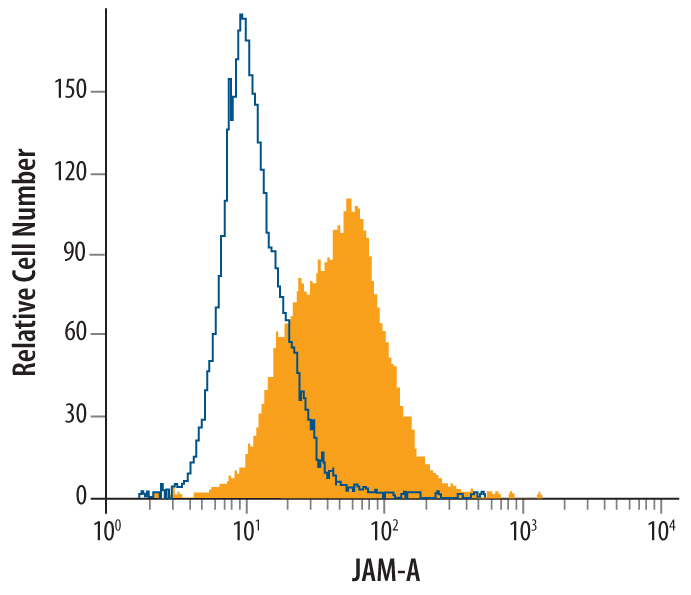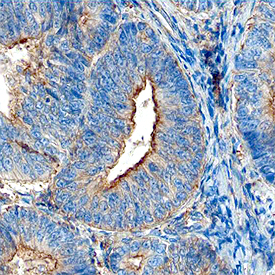Human JAM-A Antibody Summary
Ser28-Ala242 (predicted)
Accession # Q9Y624
Applications
Please Note: Optimal dilutions should be determined by each laboratory for each application. General Protocols are available in the Technical Information section on our website.
Scientific Data
 View Larger
View Larger
Detection of JAM‑A in MCF‑7 Human Cell Line by Flow Cytometry. MCF-7 human breast cancer cell line was stained with Human JAM-A Monoclonal Antibody (Catalog # MAB1103, filled histogram) or isotype control antibody (Catalog # MAB002, open histogram), followed by Phycoerythrin-conjugated Anti-Mouse IgG F(ab')2Secondary Antibody (Catalog # F0102B).
 View Larger
View Larger
JAM‑A in MCF‑7 Human Cell Line. JAM-A was detected in immersion fixed MCF-7 human breast cancer cell line using Mouse Anti-Human JAM-A Monoclonal Antibody (Catalog # MAB1103) at 20 µg/mL for 3 hours at room temperature. Cells were stained using the NorthernLights™ 493-conjugated Anti-Mouse IgG Secondary Antibody (green; Catalog # NL009) and counterstained with DAPI (blue). Specific staining was localized to intercellular junctions. View our protocol for Fluorescent ICC Staining of Cells on Coverslips.
 View Larger
View Larger
JAM-A in Human Endometrial Cancer Tissue. JAM-A was detected in immersion fixed paraffin-embedded sections of human endometrial cancer tissue using Human JAM-A Monoclonal Antibody (Catalog # MAB1103) at 15 µg/mL overnight at 4 °C. Before incubation with the primary antibody, tissue was subjected to heat-induced epitope retrieval using Antigen Retrieval Reagent-Basic (Catalog # CTS013). Tissue was stained using the Anti-Mouse HRP-DAB Cell & Tissue Staining Kit (brown; Catalog # CTS002) and counterstained with hematoxylin (blue). Specific staining was localized to the plasma membrane of glandular epithelial cells. View our protocol for Chromogenic IHC Staining of Paraffin-embedded Tissue Sections.
Reconstitution Calculator
Preparation and Storage
- 12 months from date of receipt, -20 to -70 °C as supplied.
- 1 month, 2 to 8 °C under sterile conditions after reconstitution.
- 6 months, -20 to -70 °C under sterile conditions after reconstitution.
Background: JAM-A
The family of junctional adhesion molecules (JAM), comprising at least three members, are type I transmembrane receptors belonging to the immunoglobulin (Ig) superfamily (1, 2). These proteins are localized in the tight junctions between endothelial or epithelial cells. Some family members are also found on blood leukocytes and platelets. Human JAM-A, also known as platelet adhesion molecule 1 (PAM-1) and platelet F11 receptor (3), is predominantly expressed at intercellular junctions of both epithelial cells and endothelial cells (1 - 4). It is also expressed on circulating blood cells including neutrophils, monocytes, platelets, erythrocytes and lymphocytes (5). Human JAM-A cDNA predicts a 299 amino acid (aa) residue precursor protein with a putative 27 aa signal peptide, a 210 aa extracellular region containing two Ig-like V-subset domains, a 24 aa transmembrane domain and a 38 aa cytoplasmic domain. The human and mouse proteins share approximately 67% aa sequence homology. Human JAM-A also shares approximately 35% and 32% aa sequence homology with human JAM-B and JAM-C, respectively. JAM-A exhibits homophilic interactions to regulate tight junction assembly and modulate paracellular permeability. This homophilic interation also mediates platelet aggregation and adhesion to endothelial cells and may play a role in thrombosis (3). JAM-A binds heterotypically with the beta 2 integrin lymphocyte function-associated antigen-1 (LFA-1). This JAM-A-LFA-1 interaction is involved in leukocyte adhesion and transmigration (6). JAM-A has also been shown to bind reovirus attachment protein sigma-1 to permit reovirus infection and signal virus-induced apoptosis (7).
- Chavakis, T. et al. (2003) Thromb. Haemost. 89:13.
- Aurand-Lions, M. et al. (2001) Blood 98:3699.
- Sobocka, M.B. et al. (2000) Blood 95:2600.
- Martin-Padura, I. et al. (1998) J. Cell Biol. 142:117.
- Williams, L.A. et. al. (1999) Mol. Immunol. 36:1175.
- Ostermann, G. et al. (2002) Nature Immunol. 3:151.
- Barton, E.S. et al. (2001) Cell 104:441.
Product Datasheets
Citation for Human JAM-A Antibody
R&D Systems personnel manually curate a database that contains references using R&D Systems products. The data collected includes not only links to publications in PubMed, but also provides information about sample types, species, and experimental conditions.
1 Citation: Showing 1 - 1
-
IL-18 Is Involved in Eosinophil-Mediated Tumoricidal Activity against a Colon Carcinoma Cell Line by Upregulating LFA-1 and ICAM-1.
Authors: Gatault S, Delbeke M, Driss V, Sarazin A, Dendooven A, Kahn J, Lefevre G, Capron M
J Immunol, 2015-07-27;195(5):2483-92.
Species: Human
Sample Types: Whole Cells
Applications: Neutralization
FAQs
No product specific FAQs exist for this product, however you may
View all Antibody FAQsReviews for Human JAM-A Antibody
There are currently no reviews for this product. Be the first to review Human JAM-A Antibody and earn rewards!
Have you used Human JAM-A Antibody?
Submit a review and receive an Amazon gift card.
$25/€18/£15/$25CAN/¥75 Yuan/¥2500 Yen for a review with an image
$10/€7/£6/$10 CAD/¥70 Yuan/¥1110 Yen for a review without an image







